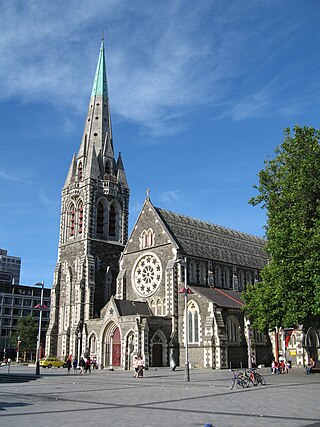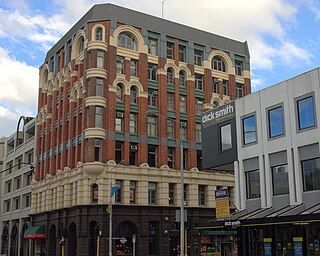
ChristChurch Cathedral, also called Christ Church Cathedral and (rarely) Cathedral Church of Christ, is a deconsecrated Anglican cathedral in the central city of Christchurch, New Zealand. It was built between 1864 and 1904 in the centre of the city, surrounded by Cathedral Square. It became the cathedral seat of the Bishop of Christchurch, who is in the New Zealand tikanga of the Anglican Church in Aotearoa, New Zealand and Polynesia.

Ao Tawhiti or Ao Tawhiti Unlimited Discovery is a state area school in Christchurch, New Zealand. The school is one of eleven schools running under the "Designated Special Character" criteria of the Education Act 1989.

The Majestic Centre, designed by Jack Manning of Manning Mitchell in association with Kendon McGrail of Jasmax Architects, was completed in 1991. The main building of the Majestic Centre is the Majestic Tower which is the tallest building in Wellington, New Zealand. The building, located on 100 Willis Street is 116 metres (381 ft) high and has 29 above ground storeys, making it the twelfth-tallest skyscraper building in New Zealand, along with the ASB Bank Centre in Auckland. It was, at the time of its completion, one of the three tallest buildings in the country, the two other contenders being built in the same year. It is to this day the southernmost skyscraper taller than 100 metres in the world. It is mainly used as office space.

The Cathedral of the Blessed Sacrament was a Catholic cathedral located on Barbadoes Street in the city centre of Christchurch, New Zealand. It was the mother church of the Roman Catholic Diocese of Christchurch and seat of the Bishop of Christchurch.

Twinkle Toes is the largest excavator in the Southern Hemisphere. It was used in Christchurch to demolish tall buildings following the 2010 and 2011 earthquakes before moving to Wellington following the 2016 Kaikōura earthquake.

Manchester Courts, earlier known as the MLC Building, was a commercial high-rise building in the Christchurch Central City. Built in 1905–1906 for the New Zealand Express Company, it was at the time the tallest commercial building in Christchurch. A Category I heritage building, it suffered serious structural damage in the 2010 Canterbury earthquake and was condemned to be demolished. Demolition began on 19 October, and was completed in late January 2011.

The Hotel Grand Chancellor was a major four-star hotel in the centre of Christchurch in New Zealand, one of eleven Hotel Grand Chancellor establishments across Australia and New Zealand. The hotel was located at 161 Cashel Street, close to the city's City Mall central shopping precinct.

St Elmo Courts was a residential high rise building constructed in 1930 in the city centre of Christchurch, New Zealand. Used mainly as an office building in later years, it had a Category II heritage listing by the New Zealand Historic Places Trust. It was demolished in March 2011, having suffered significant damage in the 2010 Canterbury earthquake and more damage in the subsequent February 2011 Christchurch earthquake.

The Press Building, located in Cathedral Square in Christchurch, was the home of The Press between 1909 and February 2011. The building, designed in the Perpendicular Gothic style, was registered with the New Zealand Historic Places Trust as a Category I heritage item, with the registration number 302. It suffered significant damage in the February 2011 Christchurch earthquake, with one staff member killed in the collapsed top floor. The building was demolished in July and August of 2011.

Clarendon Tower was a high rise building on Worcester Street at Oxford Terrace in the Christchurch Central City, New Zealand. Built on the site of the former Clarendon Hotel, the façade of the historic building was kept in the redevelopment and was protected by the New Zealand Historic Places Trust as a Category II heritage structure. Following damage from the February 2011 Christchurch earthquake, the 17-storey building has been demolished.

City Mall is the main pedestrian mall in the central city of Christchurch, New Zealand, comprising two sections of Cashel Street plus the Bridge of Remembrance and one section of High Street. It is also known colloquially as Cashel Mall. The Bridge of Remembrance was pedestrianised in 1976. The main mall was closed to traffic on 11 January 1982 and formally reopened as a pedestrian mall on 7 August, but it was not until 1992 that the entire mall was paved. The mall was redeveloped between 2006 and 2009, and track was installed for an expansion of the heritage tram network.

TheTrinity Church or Trinity Congregational Church designed by Benjamin Mountfort, later called the State Trinity Centre, is a Category I heritage building listed with Heritage New Zealand. Damaged in the 2010 Canterbury earthquake and red-stickered after the February 2011 Christchurch earthquake, the building was threatened with demolition like most other central city heritage buildings. In June 2012, it was announced that the building would be saved, repaired and earthquake strengthened. The building, post its church status, has housed some commercial operations, including the State Trinity Centre; 'The Octagon' (2006–2010); and later, following earthquake repairs, a business called 'The Church Brew Pub' (2023–present).

The implosion of Radio Network House in 2012 was the first implosion used in New Zealand to demolish a building, and was a "test case" for the potential to use such a demolition method on similar buildings in Christchurch Central City that had been damaged in the 2011 earthquake. Like most other large buildings in central Christchurch, Radio Network House was damaged beyond repair in the 2011 earthquake, and the Canterbury Earthquake Recovery Authority (CERA) added it to the demolition list in August 2011. In July 2012, it was announced that the building was going to be imploded, involving a specialist company from the United States with considerable experience in this type of work.

The Hornby Clocktower was an iconic Christchurch building, situated in the suburb of Hornby on New Zealand State Highway 1. It marked the southern entrance to Christchurch for over 50 years.

The Christchurch Central Police Station was the former headquarters of the Canterbury Police District. Once the tallest building in Christchurch, New Zealand, it was damaged in the 2011 Christchurch earthquake and demolished by implosion on 31 May 2015.

Container Mall was a temporary mall built from shipping containers in Christchurch Central City, New Zealand. It was a response to the 22 February 2011 Christchurch earthquake, which destroyed most buildings in City Mall, and resulted in the central city being cordoned off from public access while buildings were being demolished. Initially considered a short-term response to the lack of permanent buildings, Re:START was popular with locals and tourists alike and remained open for business until January 2018.

Kiwi Property Group is one of New Zealand's largest NZX-listed property companies and the owner, and manager of a range of mixed-use, office, retail and build-to-rent assets including Sylvia Park, The Base, the Vero Centre and Resido.

The Puaka–James Hight Building is the main library building of the University of Canterbury. It is named after Puaka the Māori star cluster also known as Rigel in the Orion constellation, and Sir James Hight, former, professor, and rector at Canterbury College. Rising 53-metres-tall, its distinctive brutalist design, characterised by exposed concrete, confronts the skyline and has become an enduring symbol of the institution, and the most recognisable building on campus.

The Hallensteins Building was a contemporary tower in central Christchurch, located on the High Street end of City Mall. It was sometimes referred to as the Unlimited Northern Tower due to its use as the main Unlimited Paenga Tawhiti campus building. The tower had five floors with a modern exterior, large glass windows, balconies, and a mezzanine floor on the top floor.





















